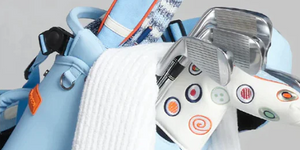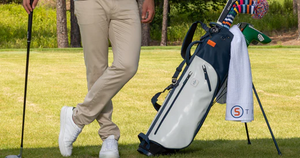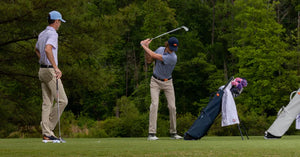What Are the Degree Loft of Golf Clubs?
Every golfer wants to launch their ball as high and far as possible.
Golf club lofts play a significant role in how much spin and launch the ball has, which affects the distance it travels.
This guide will cover the golf club loft and the different loft angles for each type.
What Is a Golf Club Loft?
The golf club loft is the angle between the clubface and the ground. It’s a crucial measurement applied to all the clubheads of golf clubs.
You can think of the loft as how much the clubface angles upwards or how much the top portion of the clubface angles back relative to the shaft.
The higher the loft angle, the higher the ball will travel. Conversely, the lower the angle, the lower the ball will go after being hit. A high-lofted club has a more horizontal face, while a low-lofted club has a more vertical face.
Additionally, you can adjust your loft by changing the angle of your wrists. Manufacturers make golf clubs with varying lofts to offer different trajectories for different shots.
Different Types of Golf Clubs and Their Loft Angles
Every golf club has a unique angle. Depending on your skill level and the performance benefits you’re looking for, it’s essential to understand the various loft angles in each club.
Driver Loft
Besides putters, drivers have the lowest loft among the golf clubs. It’s the first club to start the game, driving the ball for long distances off the tee.
Typically, the angles range between 9 and 12.5 degrees. Many players will tee the ball up 1.5 inches or more, which enables drivers to hit the ball at a slightly higher angle, adding a dynamic loft.
Players with a slow swing speed will benefit from a higher lofted driver, between 10.5 to 12.5 degrees, to hit the ball higher and farther. Faster swinging golfers will find lower loft angles between 8 to 10.5 degrees suit them better.
Fairway Wood Loft
Fairway woods are typically lower in loft compared to hybrids and irons. However, it’ll depend on the type of fairway wood you use.
The standard 3-wood is about 15 degrees; however, the range is between 13.5 and 16.5 degrees. Better players will typically opt for the lower lofted 3-woods, while golfers that struggle to get the ball in the air should consider using higher lofted options.
Most five-woods are between 17.5 and 19.5 degrees. The 5-woods can offer better spin characteristics and ball flight for long approach shots than the 3-wood. High launching woods can make sticking fast greens easier than irons, but they can also make shots more prone to go offline in windy conditions.
Most standard 7-woods are between 21 and 22.5 degrees. The 5 and 7-wood are great alternatives to long irons since it’s more forgiving and easier to hit with better ball flight characteristics. The 7-wood is a staple in many beginner and women’s golf club sets.
Hybrid Loft
Hybrids are higher-lofted than woods and offer similar loft angles as the irons. However, hybrids tend to have higher launches, more forgiving, and better spins, even though both share similar lofts.
Below are the common angles for each numbered hybrid:
- 2-hybrid: 17 degrees
- 3-hybrid: 19 to 20 degrees
- 4-hybrid: 21 to 23 degrees
- 5-hybrid: 24 to 26 degrees
- 6-hybrid: 27 to 28 degrees
- 7-hybrid: 31 degrees
The 3-hybrids have a similar loft range as 3-irons, which makes them useful for players with extreme game improvement irons.
Iron Loft
Like woods, lower iron numbers will have less loft. Below we’ve listed out the typical ranges you’ll find based on the iron number:
- 1-iron: 14 to 16 degrees
- 2-iron: 16 to 19 degrees
- 3-iron: 19 to 21 degrees
- 4-iron: 19 to 24 degrees
- 5-iron: 21 to 27 degrees
- 6-iron: 24 to 31 degrees
- 7-iron: 28 to 35 degrees
- 8-iron: 32 to 39 degrees
- 9-iron: 37 to 43 degrees
For most average golfers, the 4-iron is the lowest iron reasonable to consider playing. Since you’re only allowed to carry 14 clubs in a bag, most sets will offer 5-iron through wedges. Many players will prefer playing the hybrid over a 4-iron.
Wedge Loft
A pitching wedge ranges between 44 to 47 degrees, and many golfers use the one included in their iron set. Some pitching wedges with a game improvement iron set have lower lofts as low as 42 or 43 degrees.
Gap wedges range between 51 to 52 degrees, with some being as low as 48 degrees.
Sand wedges are between 54 to 58 degrees. As their name suggests, they offer a high enough loft to get out of the sand trap.
Lob wedges loft at 60 degrees. With such a high launch angle, you’ll get out of most blunders and produce faster shots on the green.
Putter Loft
Putters have between 3.5 to 4.5 degrees in loft. Some putters may have less or more loft. However, that usually comes down to the putter fitting, with the club specifically tailored to the individual’s stroke,
For example, if you hit the ball on the up, you’d do better with a less-lofted option. You’ll want to consider a higher lofted putter if you have a downward attack angle.
Another consideration is the greens that you most frequently play. Slow greens will require more loft than faster greens. Slow greens generally have a low roll rate, causing the ball to stay on the surface for longer.
Frequently Asked Questions
Here are the commonly asked questions about golf club lofts.
How Many Degrees Can You Change the Loft of a Golf Club?
Lofts can be changed by bending the hosel towards or away from the face plane, which opens or closes the clubface angle. For most clubs, especially irons, you can change the loft by 2 degrees since the potential effects of the bends could have on the sole angle of the club.
A one-degree change in the angle can affect your distance by two to four yards. For example, you can see 10-15 yards of difference by switching between an 8-iron with a loft of 37 to 39 degrees to a 9-iron with 41-43 degrees of loft.
Whether you’re playing golf competitively or for the health benefits, adding a few extra yards can make a world of difference.
What Is the Highest Loft on a Golf Club?
The lob wedge has the highest loft among the golf clubs. Players generally use it for navigating around barriers in the courses or shots of short distances. The high ball flight ensures a more vertical descent cutting down on the roll when the ball lands on the green.
Typically, lob wedges are about 60 degrees, but some can run up to 68 degrees. When it comes to the launch angle, that depends on the loft of the golf club combined with the swing speed.
Final Thoughts
By learning to use the loft to your advantage, you’ll select better courses based on the situation and better escape from trouble, such as overcoming obstacles.
Now you can take what you’ve learned and find the best golf clubs suited for your swing speed and playing style. When you’re ready, be sure to keep those clubs protected with a stylish but robust golf bag from STITCH.


